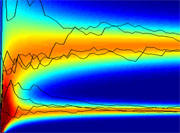Summary
The behavior and properties of macroscale objects are stable and predictable because they are the result of the average behavior of very large numbers of atoms. However, as the size of objects approaches the nanoscale, randomness emerges as a fundamental characteristic of small systems, with thermal noise, small-number statistics, and even quantum noise playing an increasingly important role. The overall aim of this project is to develop experimental and theoretical tools for the measurement, analysis and control of random processes in nanoscale systems. This will improve on traditional methods by establishing real-time, non-invasive measurement techniques with single-particle sensitivity. We focus on engineered particles in liquid environments, with the particular goal of using optical methods to make in situ measurements of the size, shape, mechanical, and transport properties of individual nanoscale objects.
Description

In liquids, the motion of a nanoparticle results from a complex interplay of fluid flow, external and internal dynamics, and random Brownian motion. Each of these processes leads to fluctuations in a measured signal. Normally it is an important (and difficult) task for the experimenter is to disentangle useful information from corruptive noise. However, the noise itself can contain useful information and one goal of this project is to exploit these fluctuations in order to determine the shape, mechanical properties, and inter-particle dynamics of individual nanoparticles in their native (liquid) environment. We approach these problems by developing new experimental techniques that allow high spatial and temporal resolution optical measurements to be made on individual particles moving freely in their native environment. We also develop methods for modeling and analyzing data that contain significant measurement noise.
Projects:
Real-Time Tracking and Fluorescence Spectroscopy
Optimal Diffusion Coefficient Estimation in Single-Particle Tracking
Nanoparticle Tracking for Fluidic Self-Assembly
Fluctuations and Nanoscale Control Software
Selected Publications:
- Simultaneous positioning and orientation of a single nano-object by flow control: theory and simulations, P. P. Mathai, A. J. Berglund, J. Alexander Liddle, and B. A. Shapiro, New Journal of Physics 13, 013027 (2011).
NIST Publication Database Journal Web Site
- Statistics of camera-based single-particle tracking, A. J. Berglund, Physical Review E 82, 011917 (2010).
NIST Publication Database Journal Web Site
- Theoretical model of errors in micromirror-based three-dimensional particle tracking, A. J. Berglund, M. D. McMahon, J. J. McClelland, and J. A. Liddle, Optics Letters 35, 1905-1907 (2010).
NIST Publication Database Journal Web Site
- Manipulating quantum dots to nanometer precision by control of flow, C. Ropp, R. Probst, Z. Cummins, R. Kumar, A. J. Berglund, S. R. Raghavan, E. Waks, and B. Shapiro, Nano Letters 10, 2525-2530 (2010).
NIST Publication Database Journal Web Site
- Fast, bias-free algorithm for tracking single particles with variable size and shape, A. J. Berglund, M. D. McMahon, J. J. McClelland, and J. A. Liddle, Optics Express 16, 14064-14075 (2008).
NIST Publication Database Journal Web Site
- Quantum dot photon statistics measured by three-dimensional particle tracking, K. McHale, A. J. Berglund, and H. Mabuchi, Nano Letters 7, 3535-3539 (2007).

